Physical Address
304 North Cardinal St.
Dorchester Center, MA 02124
Physical Address
304 North Cardinal St.
Dorchester Center, MA 02124
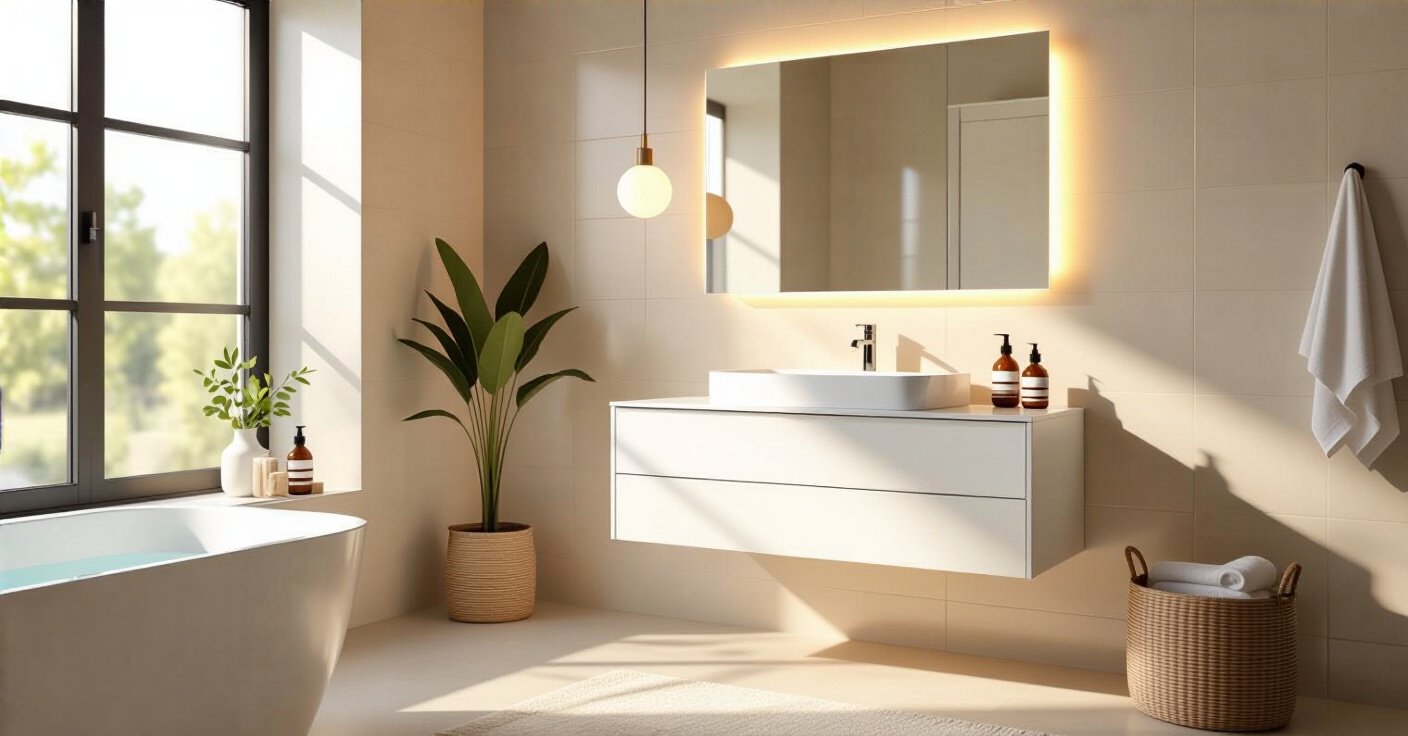
A historic architecture expert’s guide to choosing a bathroom vanity for an old house. Learn 20 practical ways to balance authentic style with modern needs.
You know what people always ask me? It’s not about flying buttresses or the history of fenestration, though I wish it were. They pull me aside, usually in a half-gutted bathroom with dust motes dancing in the light from an old window, and they whisper, “Rachel, what do I do about the vanity? I don’t want something from a big box store that looks like it belongs in a generic suburb, but I also can’t live with a porcelain wash basin and a pitcher.”
And I get it. This is where the romance of an old house crashes right into the reality of modern life. The bathroom vanity is ground zero for the battle between preservation and practicality. It has to store your electric toothbrush, your thirty-step skincare routine, and your hairdryer, all while looking like it belongs in a house that was built when plumbing was a novelty.
So here’s what actually matters. This isn’t about chasing trends; it’s about being a good steward of your home while making it work for you. Forget the glossy magazines for a minute. Let’s talk about what makes a vanity work in a place with real history and crooked walls.
Before you even think about Carrara marble or the perfect shade of Farrow & Ball paint, you have to get the foundation right. This is the unglamorous part that saves you from expensive, soul-crushing mistakes. In an old house, this stage isn’t just a suggestion; it’s a requirement. This is where you wrestle with the quirks your house has been developing for a hundred years and win.
Most design articles assume you have a nice, boring, rectangular room. We don’t have that luxury. Old house bathrooms are often carved out of former closets, pantries, or small bedrooms, leaving us with strange dimensions, sloped ceilings, or a window right where a mirror should be. Your first job is to stare at the room—I mean, really stare at it—and understand its limitations and its flow. Where is the door swing? How much space do you really have between the toilet and the tub?
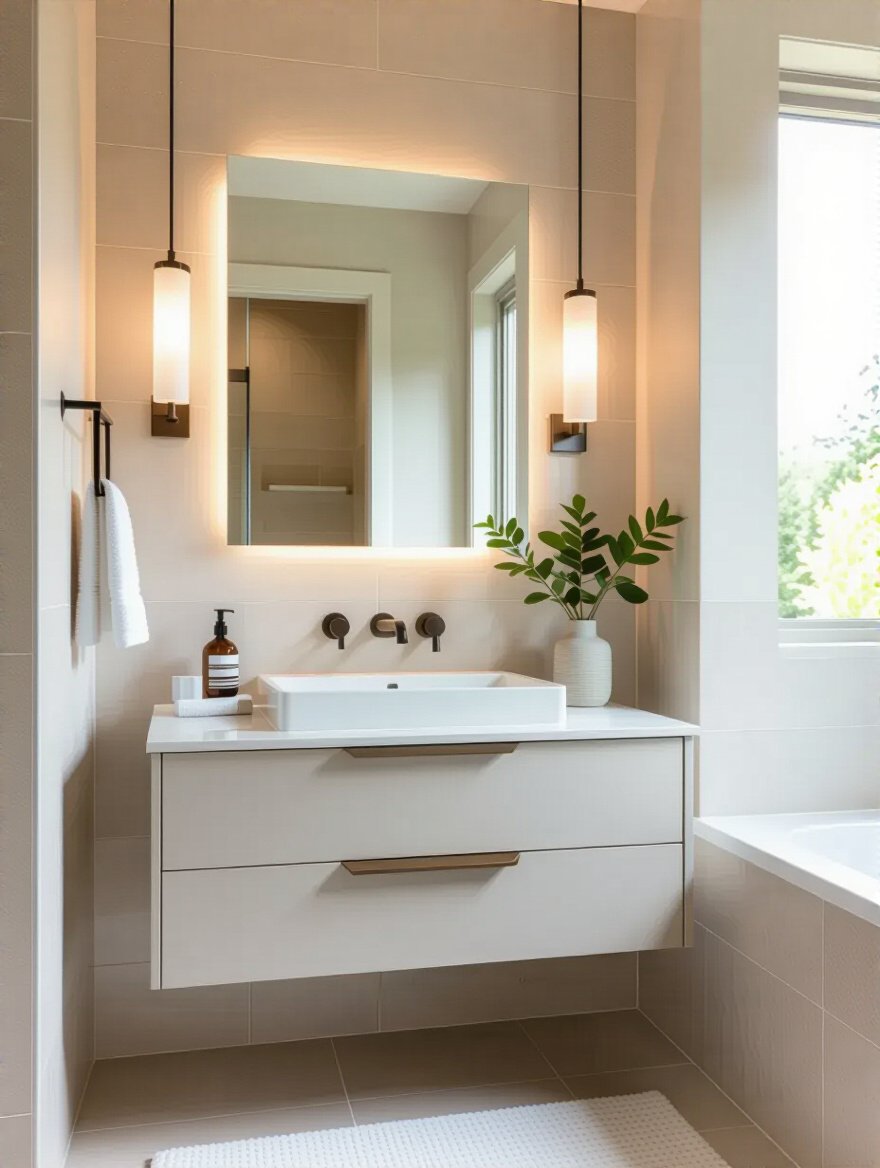
Don’t just think about where a vanity fits; think about how you will move around it every single day. I once had a client who was fixated on a massive, 60-inch double vanity for their Victorian brownstone. The problem? To fit it, they’d have to shuffle sideways to get to the shower. We ended up with two elegant 30-inch pedestal sinks, which honored the spirit of the era, cost them far less in plumbing rework, and actually let them walk through their own bathroom. Use painter’s tape on the floor to mark out the footprint of any vanity you’re considering. It feels silly, but it’s the best way to feel the physical presence of a piece before you commit.
Once you know where it’s going, you need to know exactly how big it can be.
Can we talk about why everyone gets this wrong? They measure once. In the middle of the wall. In an old house, that’s an invitation for disaster. Walls bow, floors slope, and corners are never, ever a perfect 90 degrees. You must measure the width at the top, the middle, and the bottom of the space. You need to know the depth clearance. Assume nothing is straight or level, because it probably isn’t.
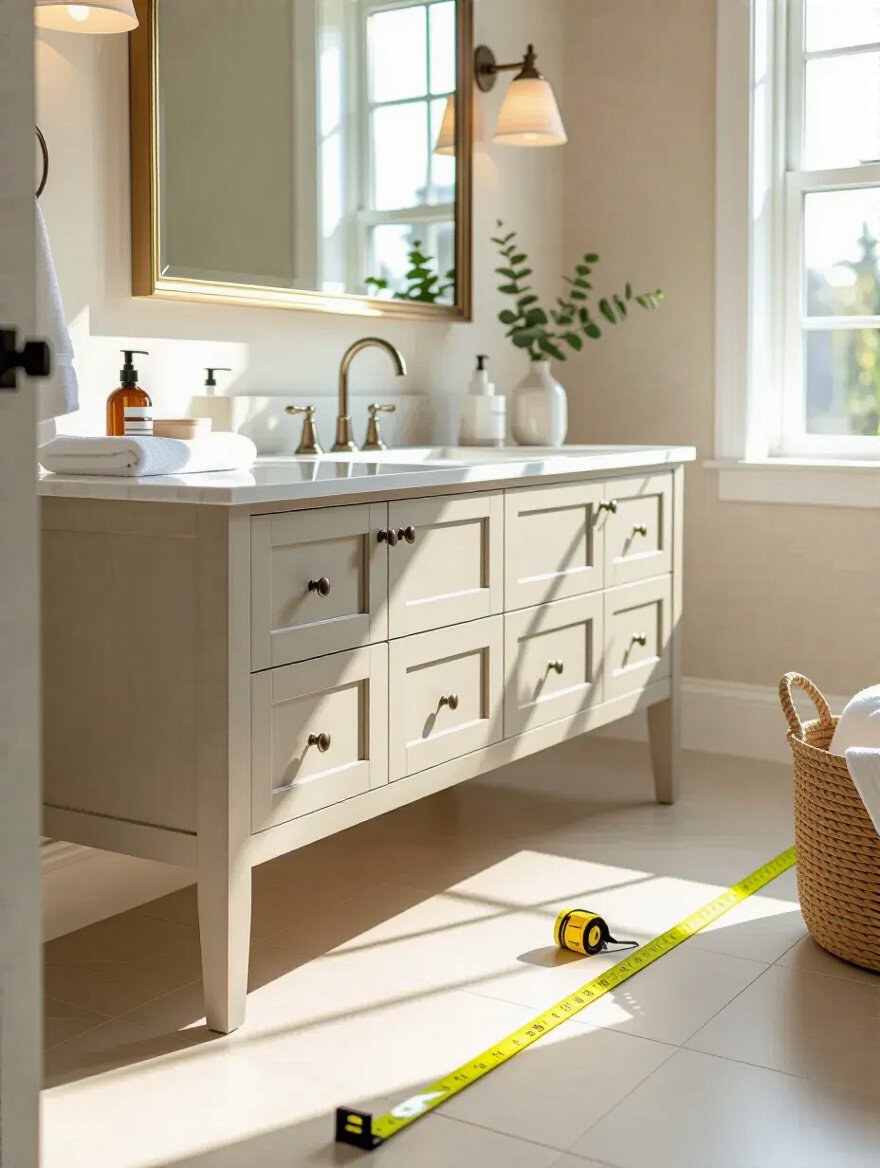
I learned this the hard way on one of my own projects, a little Arts and Crafts bungalow. I found a beautiful salvaged apothecary cabinet that I was going to have converted. I measured the alcove, and it was 36.5 inches wide. Perfect. The cabinet was 36 inches. When the delivery guys brought it in, it wouldn’t fit. The wall bowed in by almost a full inch at the bottom. We had to pay a carpenter to painstakingly scribe one side of the cabinet to fit the curve of the wall. It was a costly, time-consuming fix for a five-minute mistake. The shortcut I wish I’d known? Always, always subtract a “forgiveness” half-inch from your narrowest measurement. It will save you a world of pain during installation.
Now that you have your real-world dimensions, it’s time to talk money.
Everyone focuses on the price tag of the vanity itself. That’s a rookie mistake. The real costs are hiding in your walls. In an old house, the vanity budget is maybe 50-60% the cost of the unit. The other 40-50% is your “uh-oh” fund. That fund is for the galvanized pipes you discover have rusted through, the knob-and-tube wiring that needs to be replaced, or the patch of rot on the floorboards under the old sink.
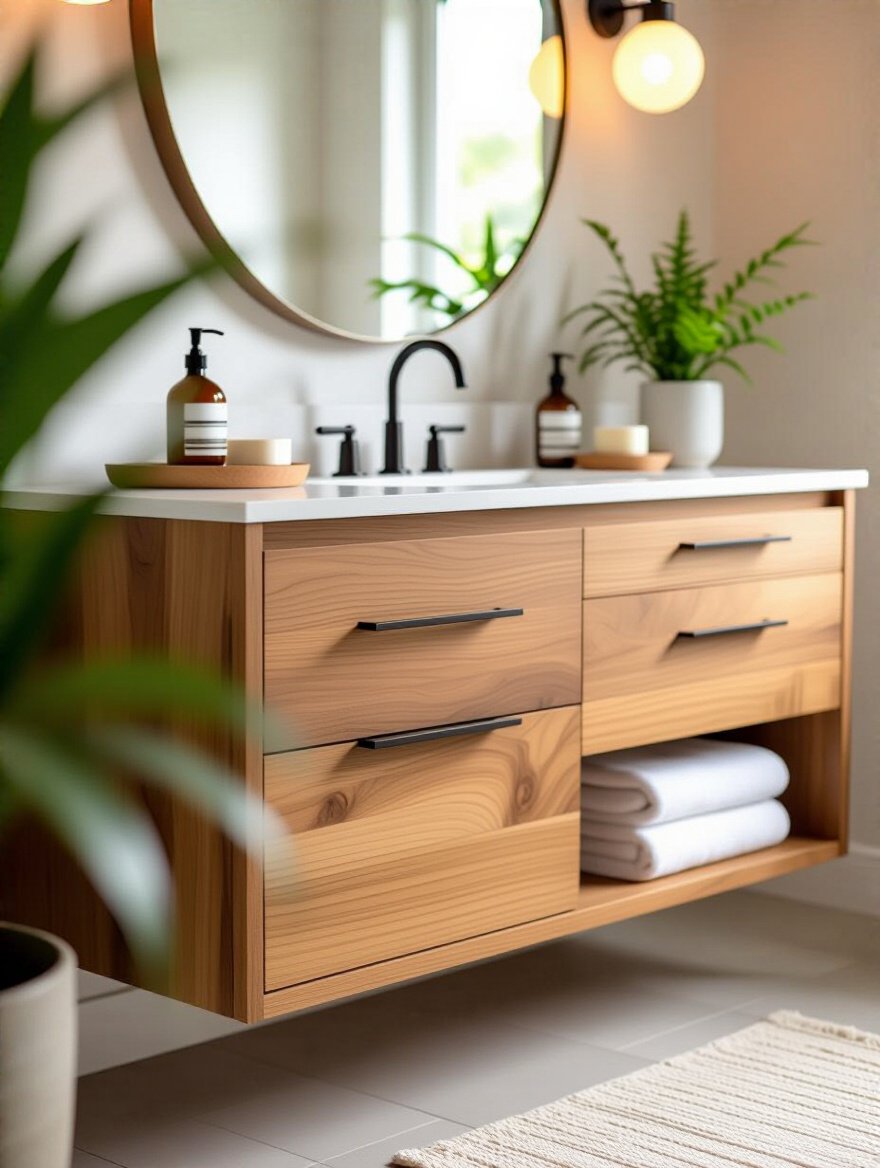
My pet peeve is when people tell me they have a $1,500 budget for a new vanity. I ask them if that includes the plumber, the electrician for the new sconces, the plasterer to fix the wall, and the inevitable surprise that will pop up. Usually, the answer is no. Be honest with yourself. Get a real quote from a plumber who has worked on old houses before you buy anything. And whatever your final, all-in number is, add 20%. If you don’t end up needing it, fantastic. But I’ve almost never seen a project in a pre-war home that didn’t need it.
With a firm number in mind, you can think about how the piece will physically exist in the space.
The way a vanity meets (or doesn’t meet) the floor has a huge impact on the feel of a historic bathroom. The trend right now is the “floating” or wall-mounted vanity. They can look great, but here’s the BS: they require incredibly solid blocking inside the wall to support their weight. Your 100-year-old lath and plaster might not be up to the task without significant reinforcement, which adds cost and complexity.
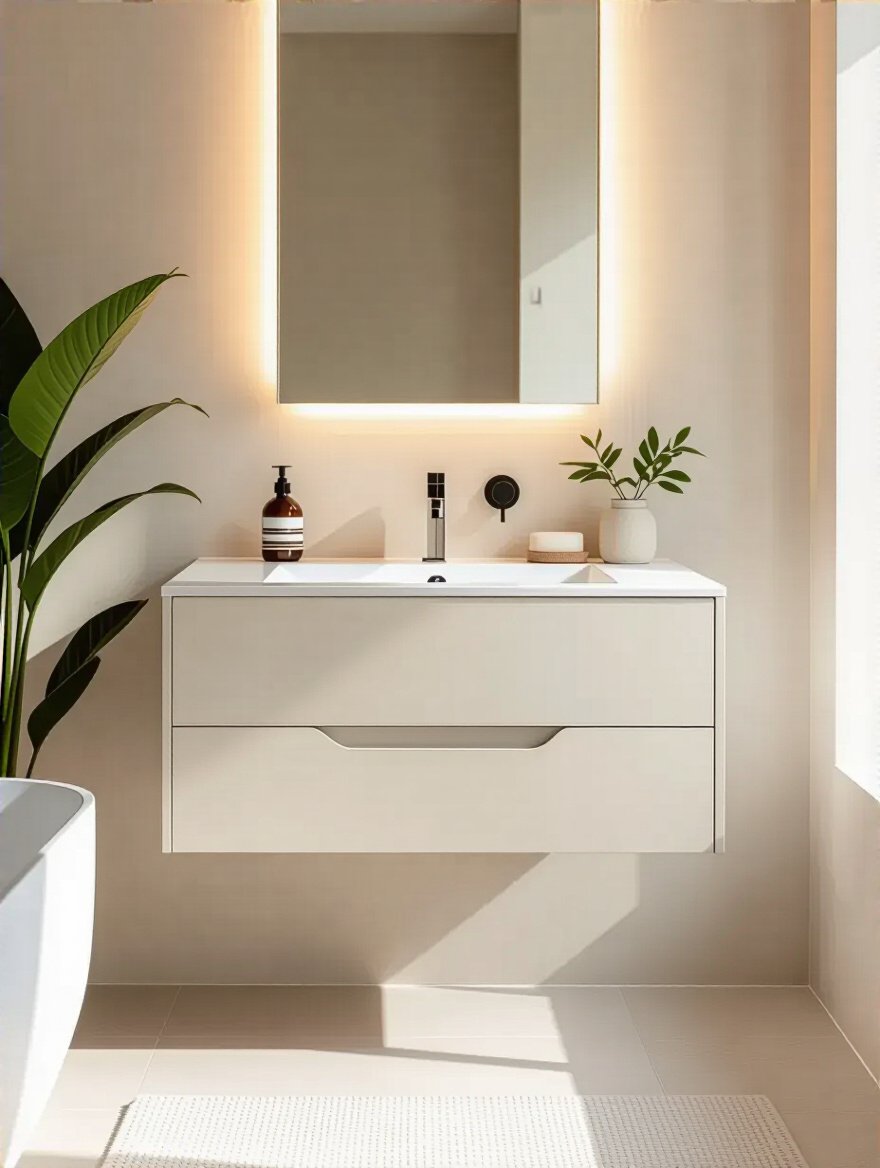
In most historic homes, a freestanding, furniture-style vanity is your best friend. It looks like a beautiful piece of furniture that just happens to have a sink in it. It feels authentic to the spirit of a home where bathrooms were once furnished with individual pieces, not built-in cabinetry. It’s also forgiving. If your floor slopes a bit, you can shim the legs. It requires no structural wall surgery. You get the stability, you get the storage, and it feels appropriate to the age of the house. I find it’s the perfect compromise.
Now for the business end of the vanity: the sink.
The single versus double vanity debate is a modern one. Historically, you wouldn’t have seen two sinks side-by-side. So, in a master bath, a double vanity can feel like a very contemporary intrusion. If you have the space and your heart is set on it, look for a unit that looks more like a long chest of drawers or a sideboard to ground it in a furniture-like aesthetic. But for most secondary or guest baths in an old home, a single sink is more appropriate.
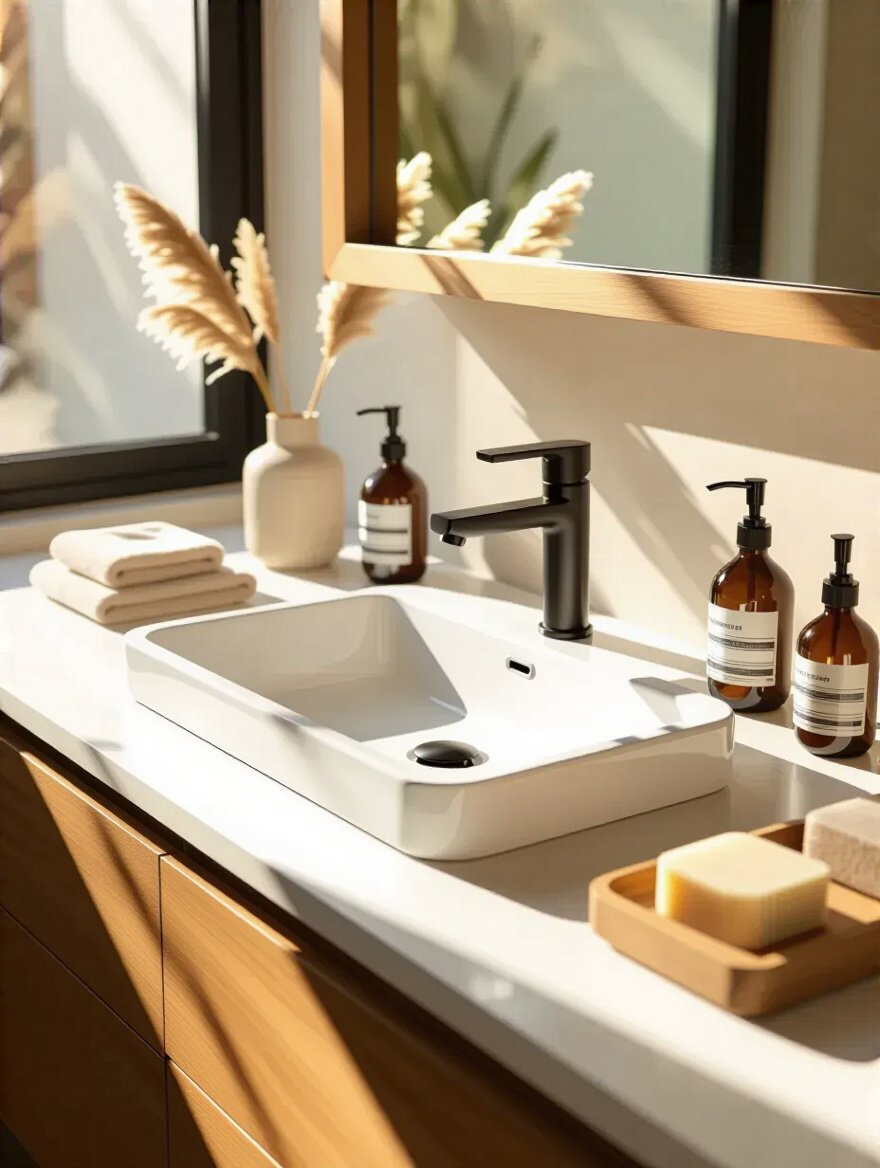
The shortcut here is to not over-prioritize the number of sinks but the amount of usable counter space around the sink. I’d rather have one sink with 18 inches of clear counter on either side than two tiny sinks with no room to even put down a toothbrush. And think hard about sink type. An undermount sink gives you that clean, continuous countertop that’s easy to wipe down. A vessel sink, while a statement, can be a splashy nightmare and feels very 2005. A classic drop-in sink with a clean profile is often a perfectly sensible and timeless choice.
Okay, you’ve done the hard, foundational work. Now for the fun part. This is where you get to imbue the piece with personality and make it sing in harmony with the rest of your home. These choices are what transform the vanity from a utilitarian box into the heart of the room.
The default choice for everyone right now seems to be quartz. And listen, it’s practical. It’s bulletproof, it doesn’t stain, and it comes in a million patterns. It’s the sensible shoes of the countertop world. But in a historic home, you have more soulful options. My heart belongs to Natural Stone. A beautiful piece of honed Carrara marble or Vermont Danby is timeless. It develops a patina over time, a story of its use. Yes, it can etch or stain. You have to seal it. You have to be okay with it not looking perfect forever.
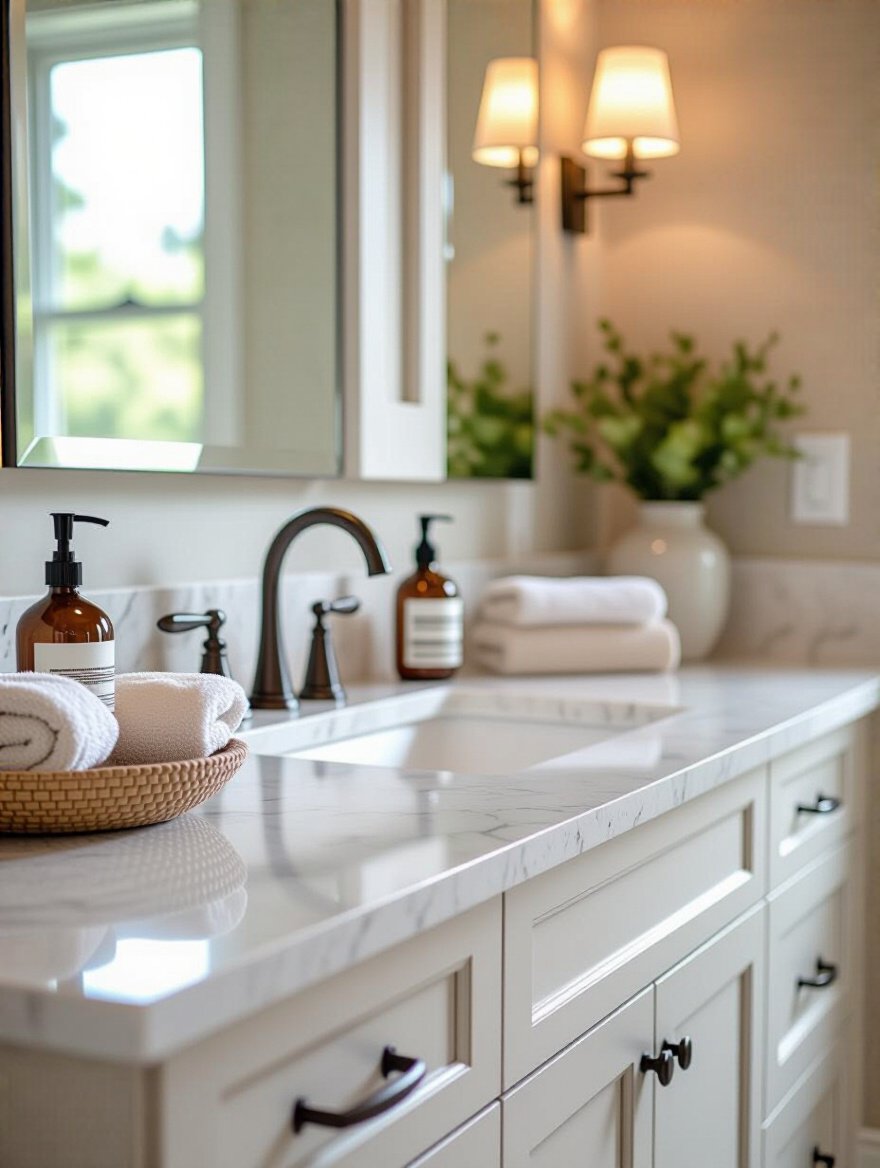
Here’s the deal: If you are the kind of person who will have a full-blown panic attack over a water ring, do not get marble. Go with quartz and don’t look back. But if you see the gentle wear as part of the home’s story, marble is unparalleled. Another fantastic, period-appropriate choice is soapstone. It’s non-porous, darkens beautifully over time, and feels right at home in a Colonial, Farmhouse, or Craftsman house. The story I tell clients is to get samples of everything. Live with them. Spill coffee on them. See what you can actually live with.
From the top, let’s move to the body of the vanity.
Please, I’m begging you, step away from the trendy, super-matte, high-gloss, or dramatically dark finish unless you have a specific, bold vision. In five years, that trendy color will scream “2020s,” and it will be the first thing a future buyer wants to rip out. For a historic home, your safest and most timeless bet is a classic painted finish in a white, cream, soft gray, or even a muted green or blue. It feels clean, traditional, and allows the architecture of the room to shine.
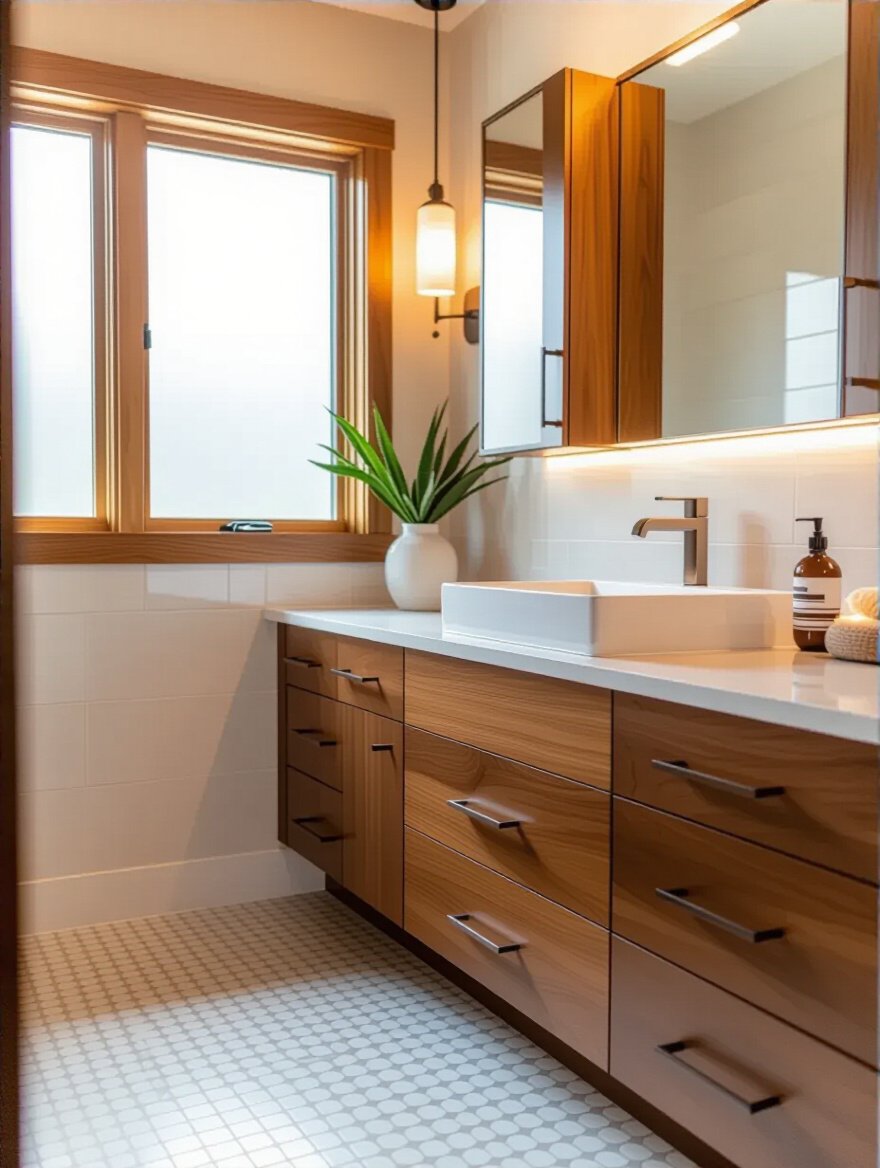
A painted finish, especially with a bit of detail like inset doors or simple Shaker panels, feels appropriate for nearly any era from Georgian to the 1940s. If you love wood, a simple stain on a wood like oak, walnut, or cherry can be beautiful, but it creates a heavier, more formal feel. My shortcut advice is this: when in doubt, go with a painted finish. It’s easier to change down the line with a simple repaint than a stained wood finish is to strip and refinish. It’s the most flexible and historically forgiving choice you can make.
Now for the piece that can make or break the entire composition.
Here is my biggest pet peeve in bathroom design: a giant, frameless sheet of mirror glued to the wall. It’s a soul-sucking void. It reflects everything, yes, but it has zero character and screams “builder-grade.” In an old house, your mirror should feel like a piece of furniture for the wall. It’s an opportunity to add style, texture, and a nod to the home’s history.
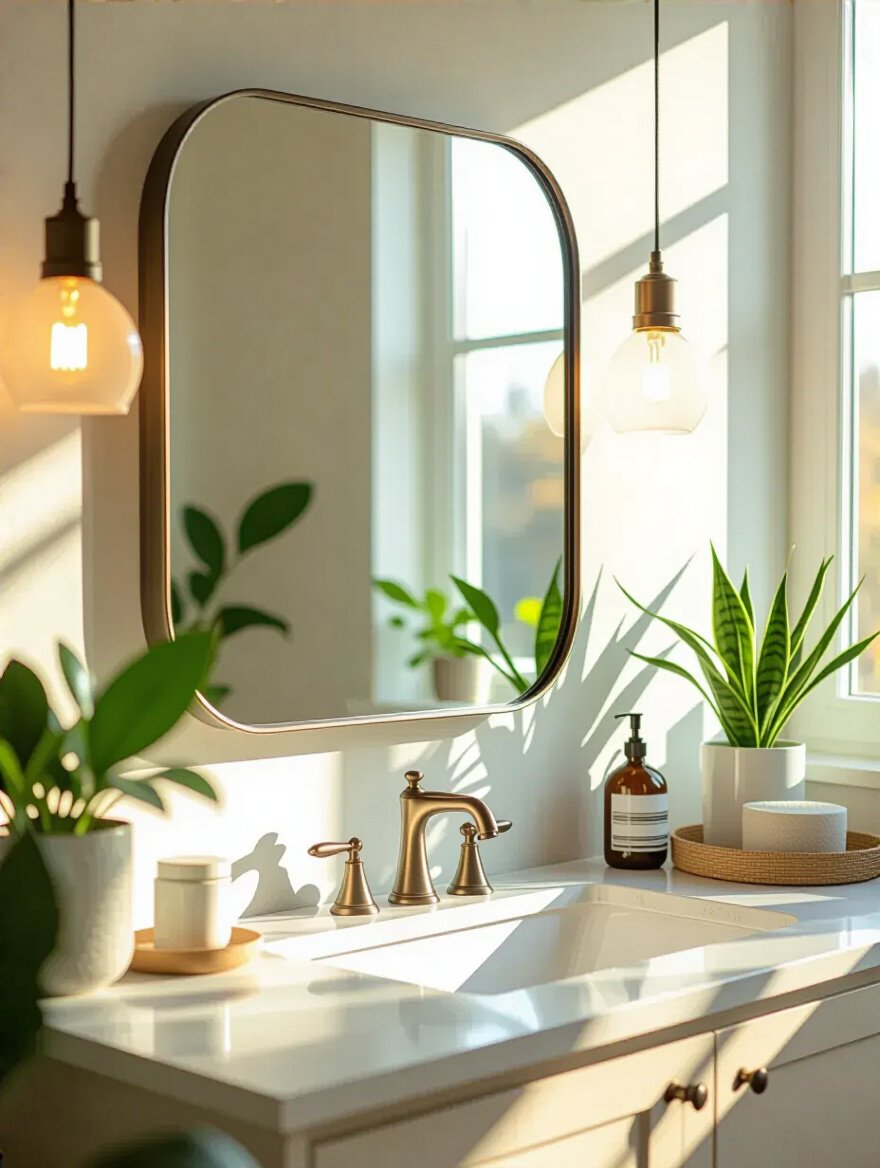
Look for a beautifully framed mirror. It could be an ornate, gilded frame for a Victorian, a simple wood frame for a Craftsman, or even a sleek metal frame for an Art Deco feel. A round mirror can soften all the hard lines of a bathroom. Or, better yet, hunt for a vintage or antique medicine cabinet. I once found a gorgeous, simple oak medicine cabinet from the 1920s at a salvage yard for $50. We cleaned it up, had a new mirror cut for the door, and it became the absolute star of a client’s small powder room. It has more soul than any smart mirror ever will.
The small details are next, and they are mighty.
Everyone else says hardware is the “jewelry” of the bathroom. It’s a tired cliché, but it’s true. It’s the one place where you can get a lot of historic character for not a lot of money. Using the wrong hardware can make a beautiful, custom vanity look cheap, and using the right hardware can make an inexpensive vanity look custom and thoughtful. It’s your secret weapon.
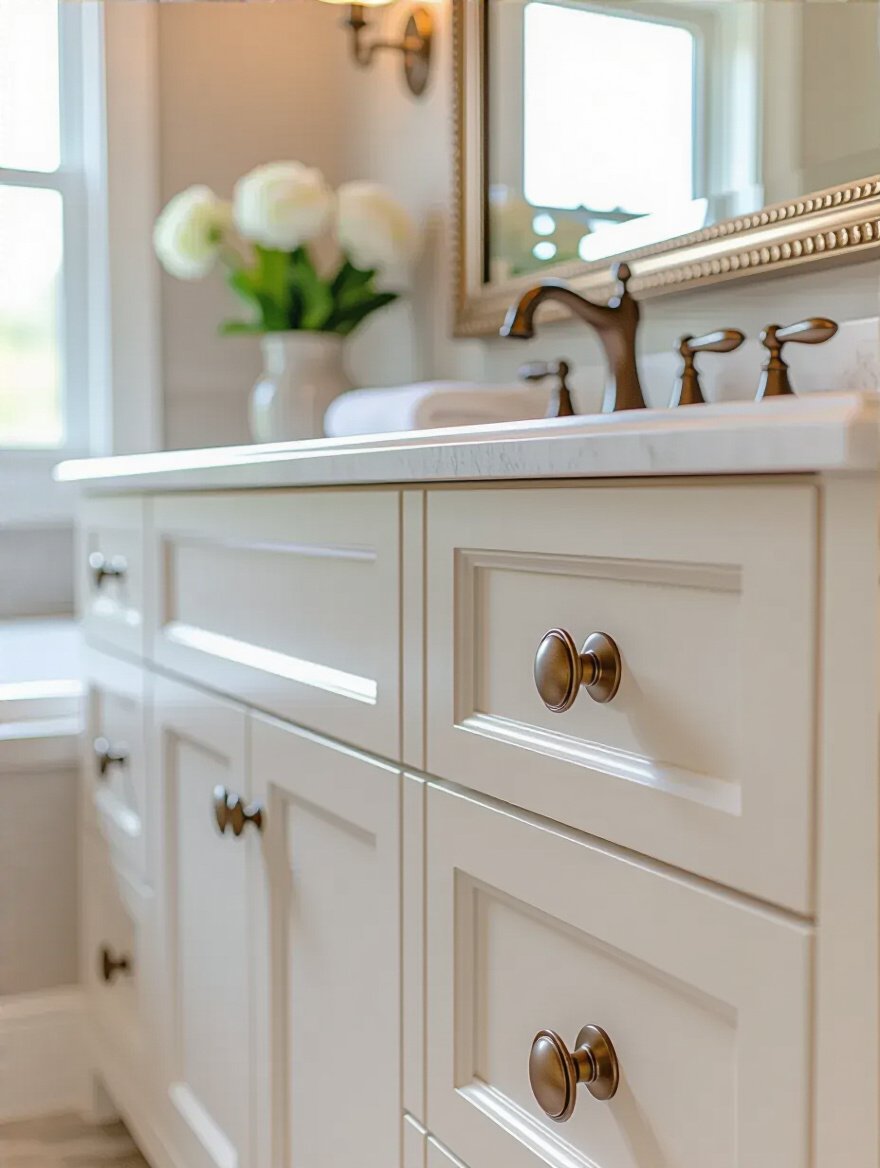
Think about the era of your house. For a Victorian, look for glass or porcelain knobs. For a Craftsman or farmhouse, look for dark bronze or iron bin pulls and simple knobs. For a Colonial Revival, polished nickel is a classic. And don’t be afraid of unlacquered brass. Yes, it will tarnish and change color over time, but that living finish is what gives it soul and makes it look like it’s always been there. The shortcut? Splurge a little here. Heavy, solid brass hardware feels substantial in your hand every single day. It’s a small luxury that makes a huge difference.
And behind it all, you need a backsplash.
The standard 4-inch strip of countertop material running up the wall as a backsplash is a purely functional, modern invention. It’s fine, but you can do so much better. The backsplash is a chance to add texture and another layer of historical reference. A simple wall of classic 3×6 subway tile is a can’t-miss choice for anything from the 1900s onward.
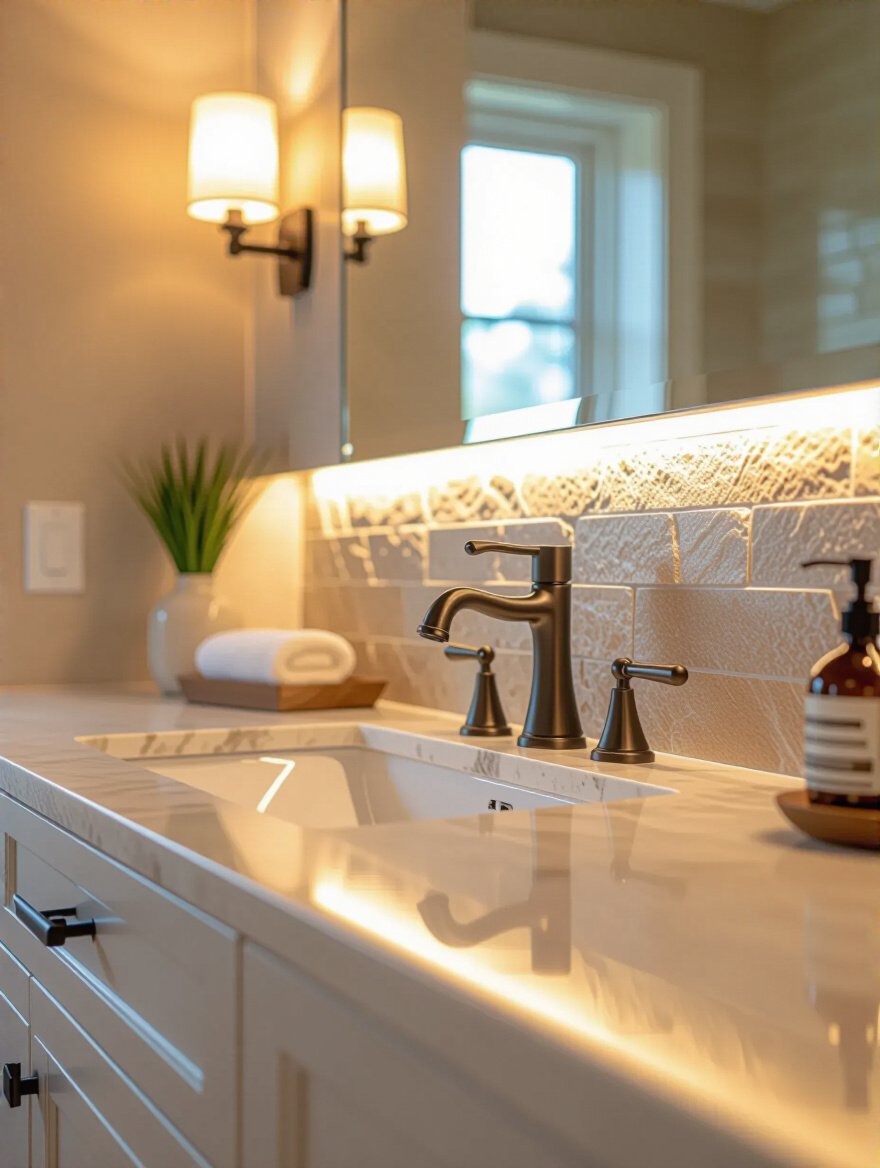
For a more country or cottage feel, beadboard paneling is a fantastic and affordable option. It’s classic, and it protects the wall while adding immense character. In a recent project, a 1910 foursquare, we used beadboard painted a soft, creamy white, running it two-thirds of the way up the wall behind the vanity. It instantly made the room feel established and cozy. The key is to think of the backsplash not as an afterthought, but as part of the entire wall treatment.
Now we get to the core of the problem: how to hide all of our 21st-century stuff. A successful vanity in a historic home is like a mullet: business in the front (looks period-appropriate), party in the back (hyper-organized, modern storage inside). This is how you get the best of both worlds.
You need to be a ruthless realist. Before you choose a vanity, empty out your current one. Put everything on the floor. Now, what do you actually need to store in here? Be honest. Once you have your pile of essentials, think about how to store them. Deep, dark cabinets are where shampoo bottles go to die. Drawers are almost always better.
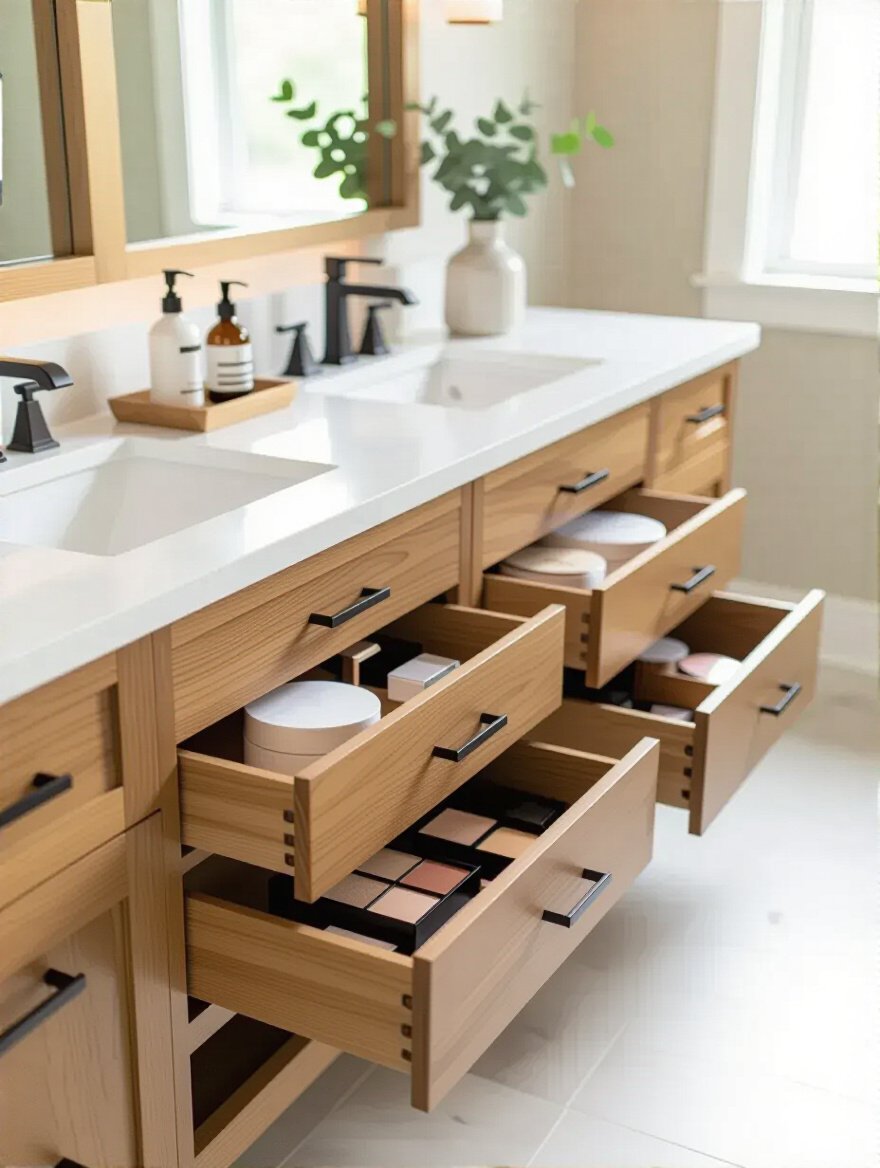
I’m a huge advocate for vanities that are primarily composed of drawers. A shallow top drawer is perfect for smaller items like makeup and toothbrushes. Deeper bottom drawers are great for bulkier items or even towels. I love using custom dividers inside the drawers. You can also get clever with the “fake” drawer in front of the sink. I’ve had carpenters turn that into a tip-out tray for sponges and toothpaste. The goal is to give every single item a home, so your beautiful new countertop stays clear and uncluttered.
To see what you’re doing, you’ll need the right light.
A single light fixture plopped in the middle of the ceiling or directly over the mirror is a recipe for frustration. It casts ghoulish shadows on your face, making every morning grooming task harder. The best, most flattering, and most historically accurate way to light a vanity is with sconces on either side of the mirror, mounted at roughly eye level.
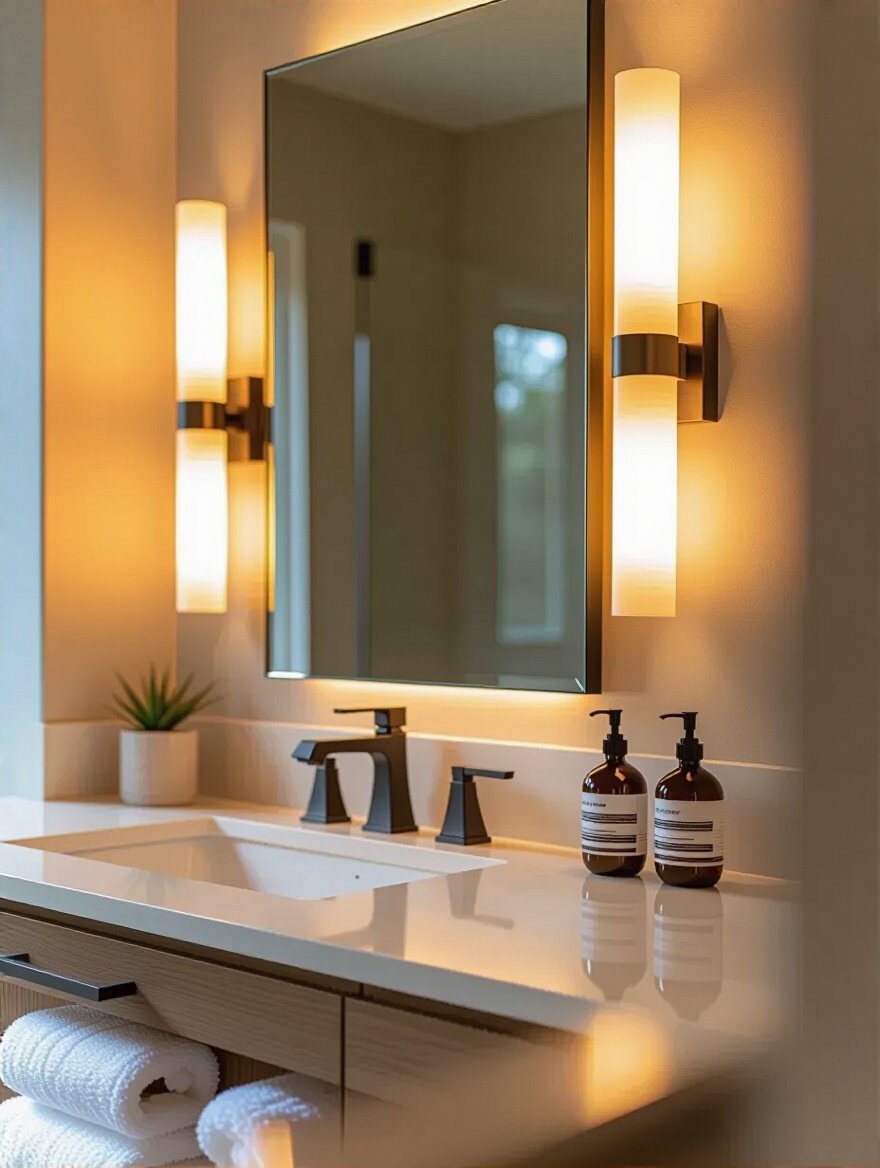
This cross-illumination lights your face evenly and eliminates shadows. It’s what professional makeup artists use, and it’s what was common in the early days of electric lighting. This is a perfect place to add historic character. You can find incredible reproduction sconces that fit any era, from colonial candle styles to Art Deco slip shades. Don’t let your electrician talk you into a single “vanity bar” light. Fight for the sconces. It’s a fight worth having.
Let’s talk about something less glamorous, but just as important.
Moisture is the great enemy of any old house, and the bathroom is its headquarters. You need a powerful, quiet exhaust fan, of course. But you can also help your vanity survive by thinking about its own ventilation. A cabinet is just a box. If humid air gets trapped inside, you get mildew and, eventually, rot. This is especially true for wooden vanities.
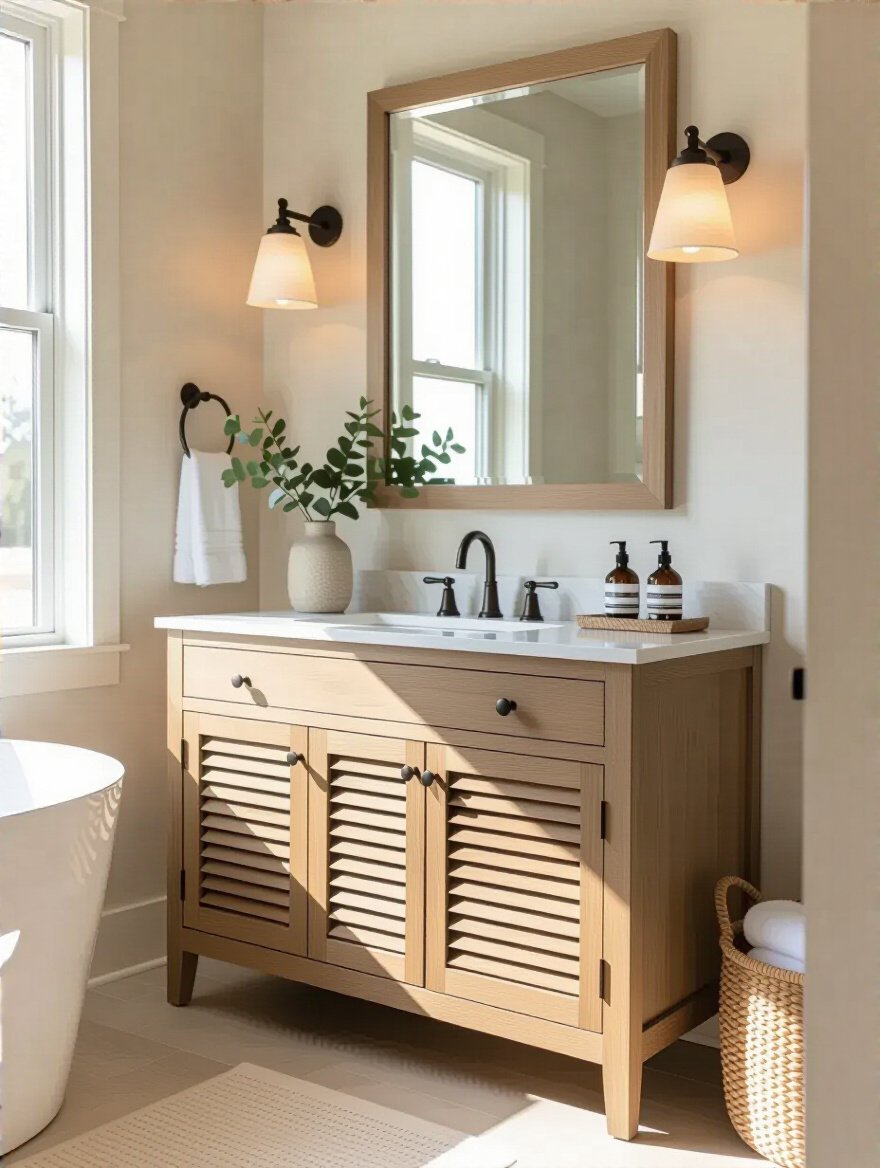
Wall-mounted or console-style vanities are great because air can circulate freely underneath them. If you have a traditional cabinet-style vanity, you can ask your cabinet maker to discreetly add vents in the toe-kick area or even use slatted or caned door fronts. On a recent project, we restored an old washstand for a powder room and intentionally left the back open behind the plumbing. It’s invisible, but it lets air move, preventing moisture from getting trapped against the wall. It’s a small detail that dramatically extends the life of the piece.
Next, a modern necessity we must integrate gracefully.
You need outlets. You just do. But a beautiful, historically inspired bathroom can be ruined by a clunky white plastic GFCI outlet staring you in the face. The goal is to make them convenient but invisible. The absolute best way to do this is with an in-drawer outlet.
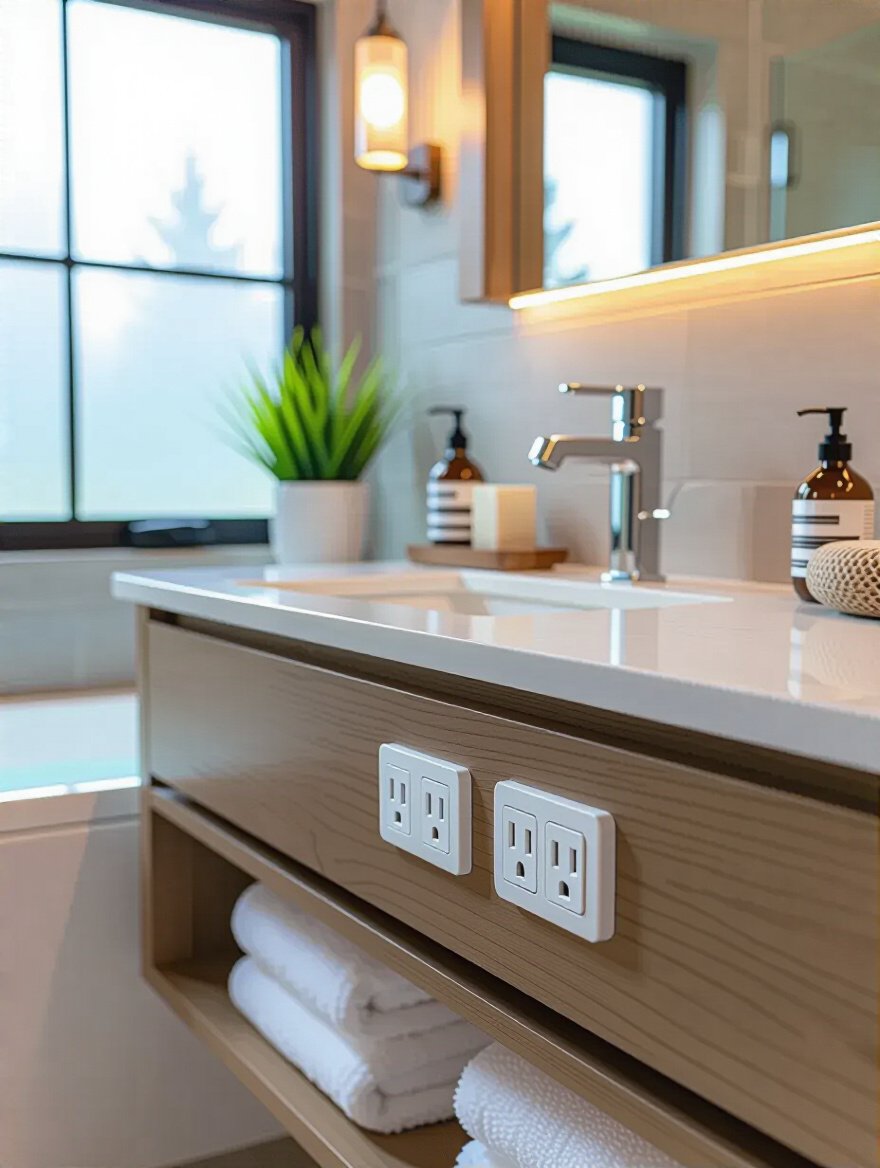
A few companies make certified, safe power strips that can be installed in a vanity drawer. You can keep your hairdryer, curling iron, or electric razor plugged in and ready to go, completely out of sight. When you close the drawer, the clutter disappears. For charging toothbrushes and phones, you can have a standard outlet installed on the side of the vanity cabinet, low down, or even inside the medicine cabinet. The point is to plan for your electrical needs from the start so you’re not left with a tangle of extension cords on your beautiful new countertop.
And finally, the part that delivers the water.
The faucet is a dead giveaway of a thoughtless renovation. A clunky, contemporary single-lever faucet on a traditional vanity looks jarring. This is another area where a little bit of research and a small splurge pays huge dividends in character. For a classic look, a widespread faucet—where the handles are separate from the spout—is always elegant. A bridge faucet, where the hot and cold lines are exposed as they rise up to the spout, is a stunning choice for a farmhouse or industrial aesthetic.
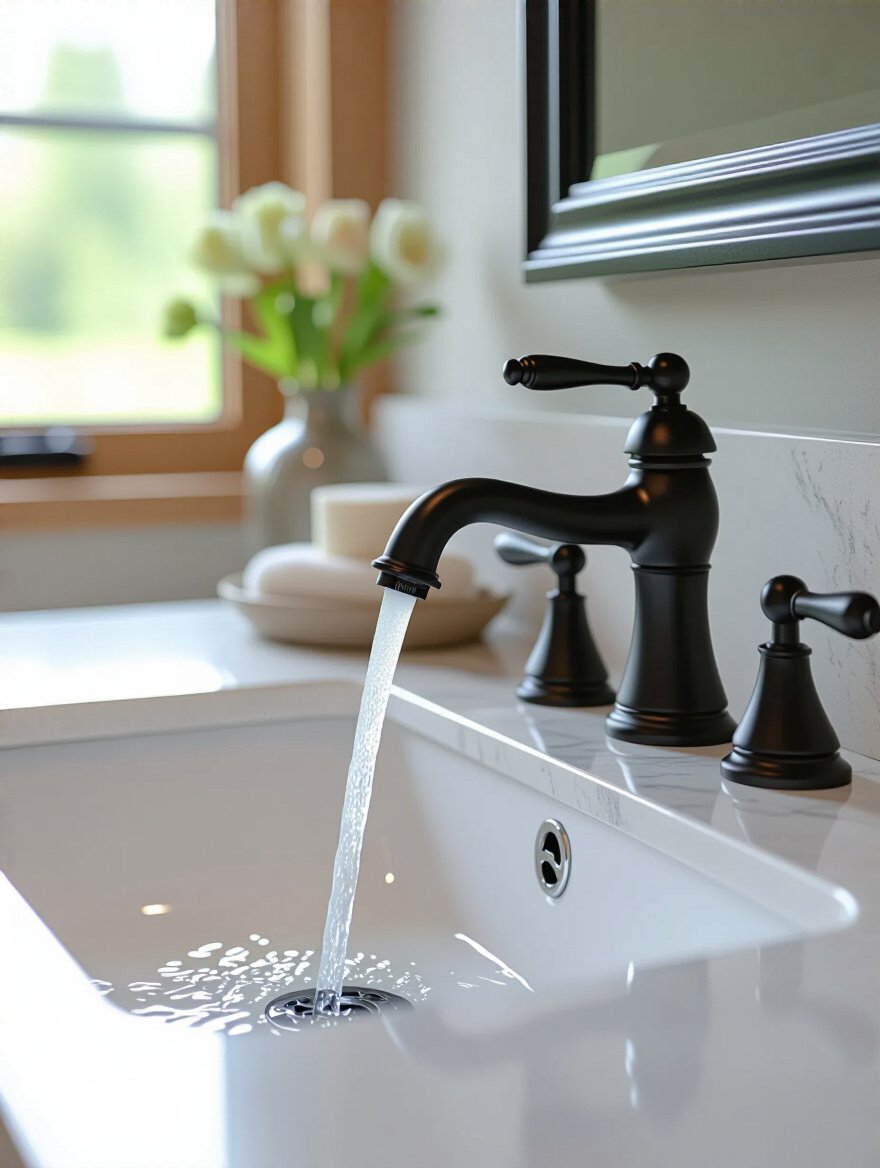
Pay attention to the finish. Polished nickel has a warmer, more golden hue than chrome and feels much more traditional. As I said before, unlacquered brass is my favorite for a living finish that patinates over time. But more than style, make sure the faucet functions with your sink. The spout has to be long enough to reach the middle of the basin, and tall enough for you to comfortably wash your hands. Don’t fall in love with a look without checking the specs.
You’ve got the basics down. Your vanity is planned, functional, and beautiful. But we can go deeper. This is where we solve the really tricky problems of old houses or add that final layer of thoughtful detail that elevates the entire project from good to exceptional.
Old houses are famous for their comically small bathrooms. Sometimes, even a standard-depth vanity is too deep. This is where you need to look at specialty, space-saving designs. A console sink is one of my favorite solutions. It consists of a sink top supported by legs, with an open shelf below. You get the countertop space and a place for a basket of towels, but because it’s visually open, it makes the room feel much larger.
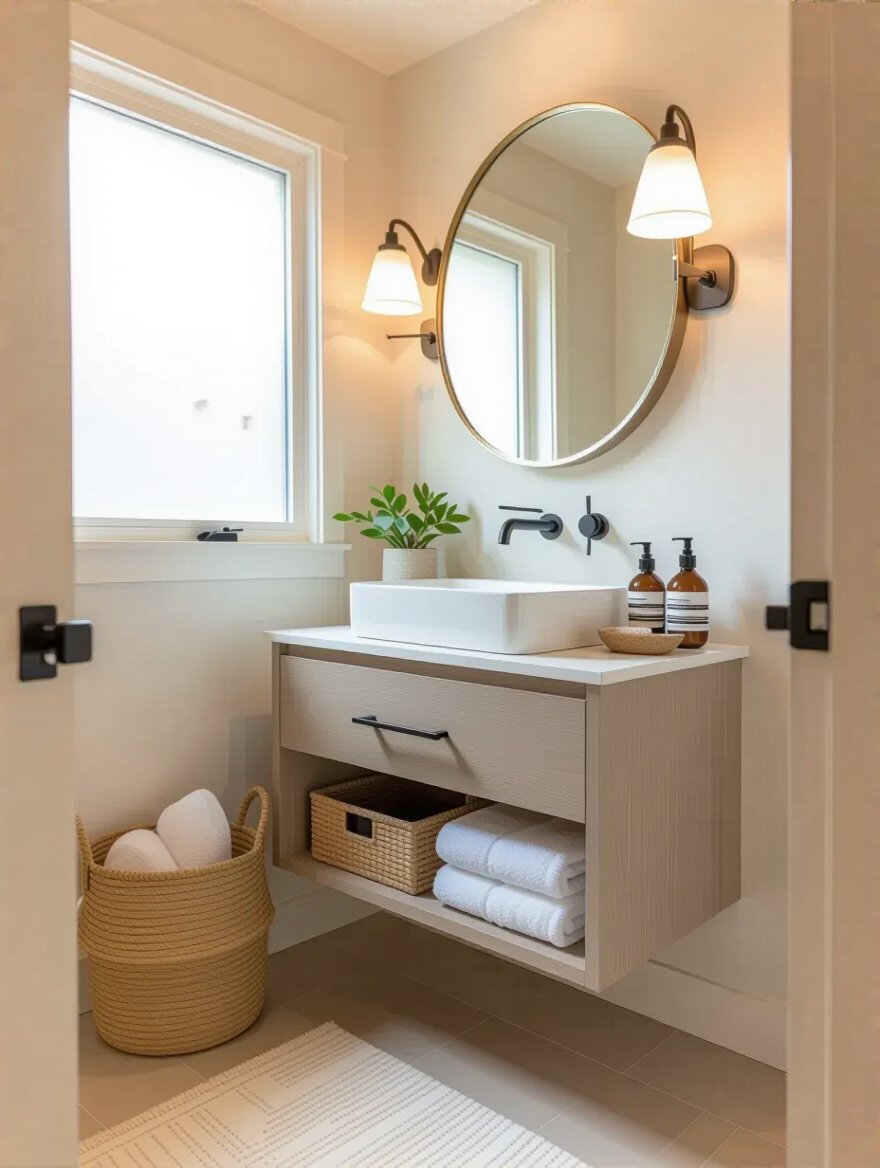
Corner vanities can sometimes be a solution, but often they create more awkward space than they solve. A better bet is a narrow-depth vanity. Some manufacturers make them as slim as 18 inches deep (or even less), which can be a lifesaver in a tight spot. In a tiny attic bathroom, we once had a custom vanity built to only 16 inches deep, and paired it with a wall-mounted faucet to save every last inch of counter space. It was the only way to make the room work, and the custom fit made it feel intentional and luxurious, not compromised.
The fit isn’t just about width and depth; it’s also about height.
Did you know that original antique washstands were often quite low, around 30 inches? That was fine for a quick splash from a basin, but for daily use, it’s a back-breaker. “Comfort height,” which is around 36 inches (the same as a kitchen counter), is a modern standard, and it’s a welcome one. This is a perfect example of where we should absolutely adapt an old house for modern living.
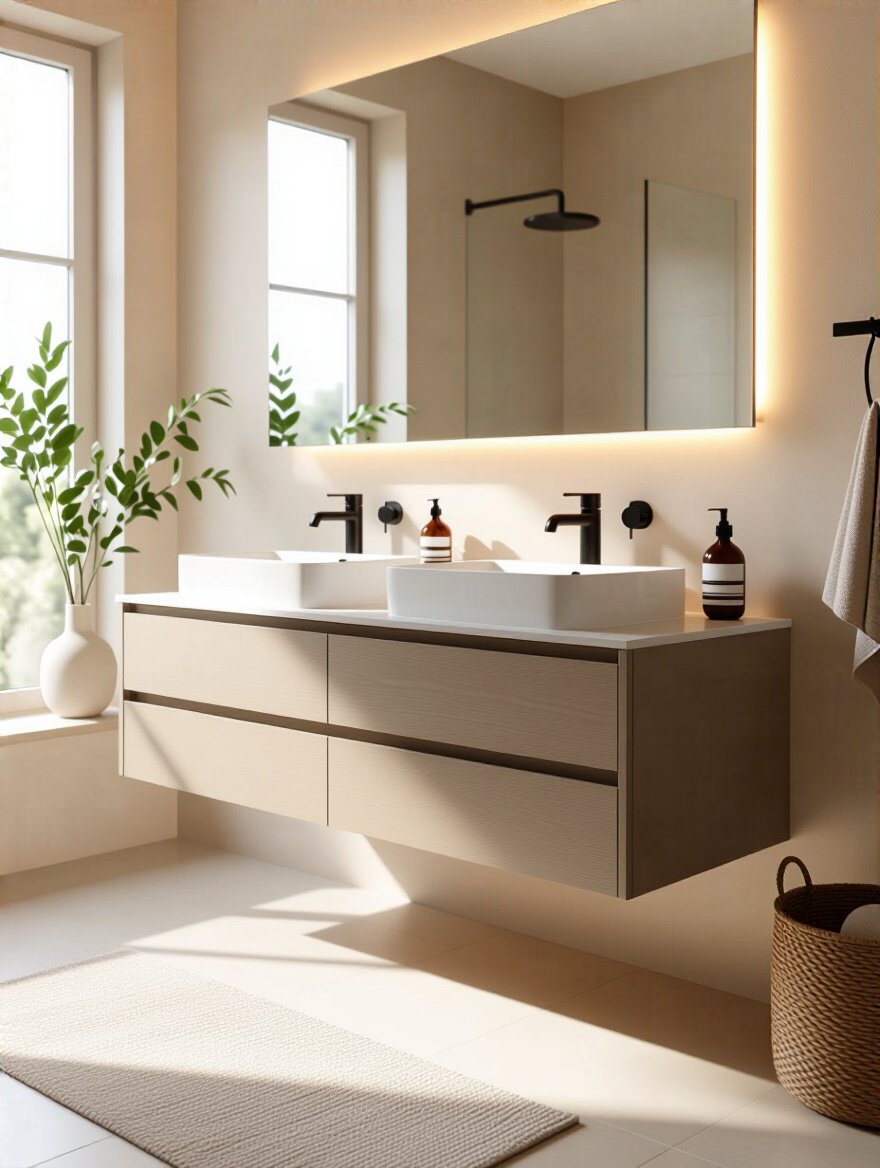
Choosing your vanity height is a chance to get it just right for you. If you’re particularly tall, a 36-inch vanity will feel so much better than the old 32-inch standard. If you’re designing a bathroom for aging in place, a slightly lower, accessible height of 34 inches with open knee space below is a compassionate and smart choice. Don’t just accept the standard height. Think about who is using the bathroom every day and tailor it to them.
Sometimes, the only way to get it right is to have it made just for you.
When you have a truly bizarre space—a deep alcove, a wall with a dramatic slope, a series of unavoidable pipes—a custom vanity is not a luxury, it’s a necessity. It’s the only way to turn an awkward liability into a unique, functional asset. The extra cost of a custom piece is often offset by the incredible gain in functionality and the fact that it will look perfectly, seamlessly integrated.

My advice here is to find a local cabinet maker or carpenter, not a big company. Find a craftsperson who appreciates old homes, someone who gets excited about the challenge of a crooked wall. I worked with a client to design a vanity for a bathroom under the eaves of their Tudor home. A local woodworker built a beautiful oak vanity that was full depth on one side and tapered to only 10 inches deep on the other to follow the slope of the roofline. It unlocked a huge amount of storage in a previously unusable space and became the most commented-on feature in the house.
What about bringing a little 21st-century tech into your 19th-century home?
Okay, let’s be real. Do you need to check your email on your bathroom mirror in your 1890 Queen Anne? No. You do not. Most “smart” bathroom tech is gimmicky and will look horribly dated in a few years. But there are a few exceptions that are genuinely useful and can be integrated discreetly.
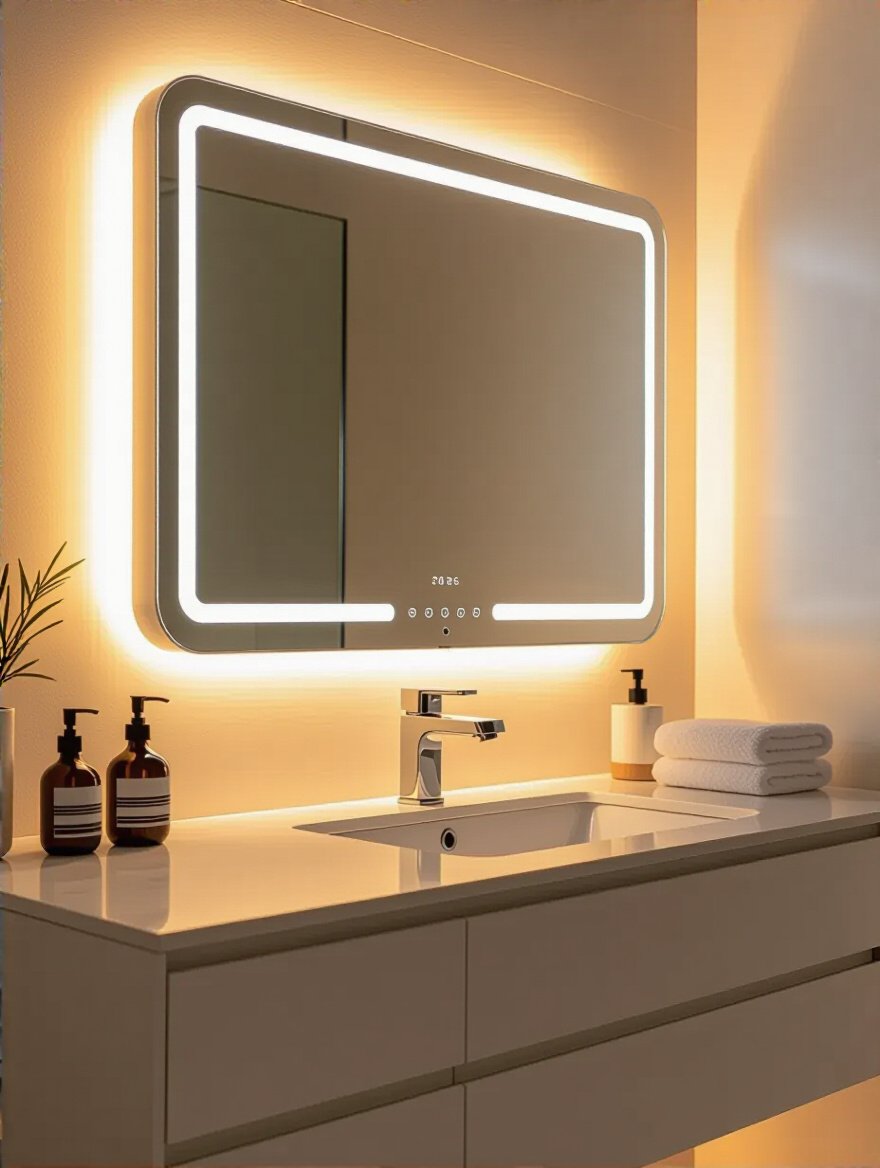
The single best piece of smart tech for a vanity is an integrated mirror defogger. It’s a heating pad on the back of the mirror that keeps a section clear, even after a steamy shower. It’s a simple, invisible luxury. The second is tunable LED lighting. This can be integrated into a medicine cabinet or sconces, allowing you to change the color temperature from a warm, relaxing glow in the evening to a bright, cool light for makeup in the morning. Focus on technology that solves a real problem, not technology for technology’s sake.
And finally, a choice that aligns perfectly with the spirit of preservation.
The very act of preserving an old house is an act of sustainability. You’re recycling an entire building. Why not extend that ethos to the materials you put inside it? Instead of a vanity made from virgin timber and full of formaldehyde-laden adhesives, you can make much healthier, more responsible choices.
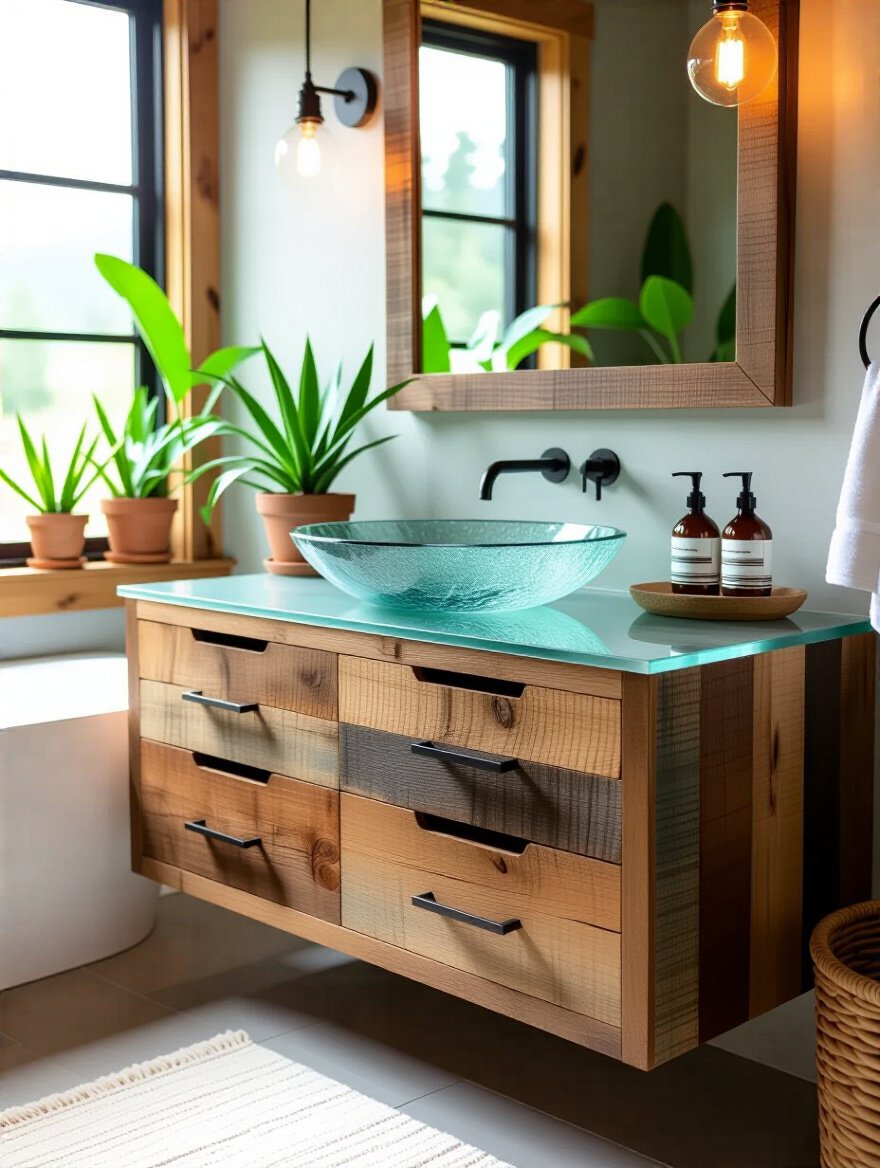
Look for vanities made from reclaimed wood. Salvaged wood from old barns or dismantled buildings has a character and patina you can’t fake. Choose countertops made from recycled glass or other composite materials. Most importantly, insist on low-VOC or zero-VOC finishes, paints, and glues. These emit far fewer harmful chemicals into your air, making your home healthier. This isn’t about compromise; a vanity built from solid, reclaimed wood by a local artisan is often higher quality and will last longer than almost any mass-produced alternative.
So, that’s the real story. Choosing a vanity for your historic home isn’t just about picking a box with a sink in it. It’s a thoughtful process of balancing history with your life today. It’s about respecting the quirks and character of your house while insisting that it serves you, your family, and your morning routine.
You’re not just a homeowner; you’re a steward. Every choice you make, from the height of the counter to the finish on the drawer pulls, adds to the home’s long story. Armed with this knowledge, you can go beyond the generic and create something that feels authentic, works beautifully, and brings you a little bit of joy every time you use it. Your perfect bathroom isn’t in a catalog; it’s waiting for you to create it, thoughtfully and confidently.